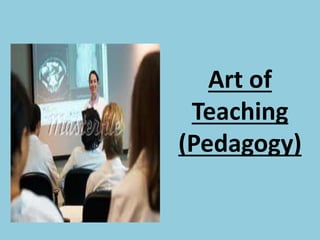
2. art of teaching.ppt
- 2. Learning objectives 1. What is teaching? 2. What is the purpose of teaching? 3. What is the process of teaching? 4. What are the types of teaching? 5. What are the various teaching methods? 6. What are the qualities of good teaching? 7. How best to teach? 8. How to assess your teaching?
- 3. Performance objectives • One can perform 1. Better in communicating a message to any audience in future. 2. He can use any one of the methods as such or with modifications in future. 3. One can develop automatism and ex- tempore teaching by understanding these concepts and practices.
- 5. • Teaching is a process intended for learning by inducing a behavioural change in the taught. • It is an art of communicating a message with impact on audience. • Pedagogy is an art or profession of teaching.
- 7. Teaching creates knowledge awareness and feelings in the taught and brings about behavioral change.
- 9. Teaching process • Teacher Message Taught • Well (CABS) prepared CLEAR, SENSITIZED AND RECEPTIVE ACCURATE BRIEF SPECIFIC • No Communication barriers
- 10. Learning cycle COGNITIVE DOMAIN KNOWING KNOWLEDGE ATTITUDE PRACTICE AFFECTIVE PSYCHOMOTOR DOMAIN DOMAIN BEING DOING TEACHING
- 12. Teaching equips • Cognitive domain with knowledge and psychomotor domain with feelings and interest. • Both these domains affect the affective domain to do or practice. • If this practicing of teaching is done on regular basis with positive feeling ,liking for the subject , subject will be internally absorbed and retained (internalization) • Whenever the it is needed, the cognitive domain provides or recalls the stored facts and concepts automatically( automatism) • Then one can profess about the subject.
- 13. Who is a Professor? • Once the affective domain is enriched with knowledge and positive attitude Internalization of the subject ( subject will be assimilated) will occur. • Internalization will lead to development of automatism( recalling the concepts and the facts about subject automatically) and command over the subject. • Then he can profess about that subject (becomes a professor)
- 15. TYPES OF TEACHING •ACTIVE •PASSIVE •LEARNER ORIENTED •TEACHER ORIENTED
- 17. 1. Lecture 2. Lecture discussion 3. Seminar 4. Symposium 5. Panel discussion 6. Group discussion 7. Tutorials 8. Role play 9. Integrated teaching (horizontal and vertical) 10. Talking point sessions 11. Workshops 12. Conferences
- 19. • Good Concept ( thorough preparation) • Organized Content( lesson planning) • Good Quality and optimum quantity • Sequence • Relevance • Learner oriented
- 20. How to teach?
- 21. TEACHING PRACTICE 1.SET INDUCTION 2.INTRODUCING TOPIC 3.TOPIC ORGANIZATION 4.REINFORCING OR STIMULATING 5.SUMMARIZING
- 22. Set induction • Bringing the mood of the audience into the topic. • Make sure that your audience is ready to receive the message you are going to deliver by any means which will make them attentive and receptive like: 1. Verbal questioning 2. Handouts 3. Problem/exercises
- 23. Introduction to the topic • Introduce the topic to the students by means of 1.Title 2.Learning objectives 3.Performance objectives
- 24. Organizing the topic • Prepare lesson plan keeping in mind 1. Relevance 2. Sequence 3. Editing 4. Time management
- 25. Reinforcement • Make the lesson both comprehensive and interesting by • Reinforcing with 1. Facts and figures 2. Problems/exercises 3. Giving Examples 4. Making it a two way lecture discussion by asking few questions( particularly the students who are not attentive.
- 26. Stimulation • Make it more interesting and lively by 1. Repetition of the main points 2. Stressing the important ones 3. Pauses to make something more effective 4. Relevant personal experiences 5. Purposeful body movements, gestures, voice modulations, eye contact etc.
- 27. Teacher is the main one Teacher teaches ( not the black board, OHP or PPT)
- 28. Teaching flows • Teaching is a flow of thoughts ( stream of thoughts). • It is a continuous process , hence there should be no unwanted interruptions.
- 30. Summarizing • Summarize your lecture • By checking whether you have explained all the learning objectives you have chosen. • Just repeat your learning objectives giving stress on main points. • Please note that summarization is not evaluation or assessment of impact of your lecture. It completes just delivery of lecture, but does not measure the impact of lecture on the audience.
- 32. Impact assessment • Can be done in several ways • One sided (by teacher himself) • Two sided (teacher and student) • third party assessment
- 33. Evaluation • Self designed using the understanding of the learning objectives of the lecture as criteria. Or • Basing on the basics of any lecture like the content, quality of presentation etc
- 34. Teaching is an art (not just reading from a book and reproducing in the class room).
- 35. Teaching dimensions Teacher development is mutual with the student development and vice versa.
- 36. Managing the students Don’t throw the blame on the students for your failure to create an impact with your lecture. Students are immature, less skilled, emotional and You are mature, more skilled and composed. Best way to control the students is by giving them best lectures.